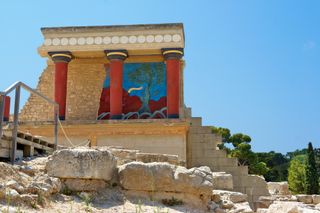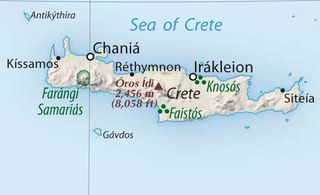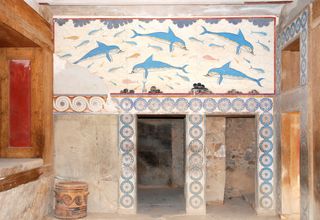Knossos: Palace of the Minoans

The Palace of Knossos is located just south of modern-day Heraklion near the north coast of Crete. Built by a civilization that we call the Minoans, it covers about 150,000 square feet (14,000 square meters), the size of more than two football fields, and was surrounded by a town in antiquity. The site came to prominence in the early 20th century when it was excavated and restored by a team led by British archaeologist Arthur Evans.
When the palace was first constructed "it must have been a remarkable sight, quite unlike anything seen on Crete before," writes J. Lesley Fitton in her book "Minoans (Peoples of the Past)" (British Museum Press, 2002). She notes that although other settlements on Crete around this time built palaces of their own, none was as large as Knossos. "Knossos perhaps began as a 'first among equals,' and the relationship between the powerful groups that built the palaces may not have been entirely friendly." The position of Knossos was not accidental, and Fitton notes that it lines up with a sanctuary located at Mount Juktas to the south.
Mysteries and destructions
Despite the fact that the palace was excavated a century ago there are still many questions that researchers have about the palace and the people who lived in it.
For instance, the chronology of the palace is a matter of scholarly debate. Construction of the palace appears to have begun around 1950 B.C., although there may have been structures predating it. This "first palace" (as it is sometimes called) was damaged (likely by earthquakes) around 1700 B.C. and a second palace was built on top of it. Recently, however, scholars have called into question how extensively this "first palace" was damaged, write researchers Colin Macdonald and Carl Knappett in a chapter of the book "Intermezzo: Intermediacy and Regeneration in Middle Minoan III Palatial Crete" (British School at Athens, 2013). The papers published in their book raise the possibility that rather than a "first" and "second" palace, there were several phases of renovation and change that occurred over a period of centuries.

The actual name of the people who lived in the palace is unknown. The Minoan writing system is undeciphered and the name "Minoans" comes from Arthur Evans, who believed that he had found the palace of "King Minos," a mythical Cretan king who supposedly constructed a great labyrinth on Crete. Today, archaeologists know that King Minos likely did not build this palace.
Researchers do know that the palace suffered from several disasters throughout its history. The palace likely suffered disruption around 1600 B.C., when the eruption of a volcano on Thera caused a tsunami that hit parts of Crete. The palace was hit with another catastrophe (of some form) around 1450 B.C., when sites across Crete were destroyed and a people who modern-day scholars call the "Mycenaeans" occupied Knossos. The final destruction of the palace probably took place sometime before 1300 B.C.
The first palace
Although the remains of the "first palace" mostly lie under later palace renovations, archaeologists have been able to put together a rough picture of what it looked like in antiquity.
The first palace was built around a central court and contained numerous storage areas, including magazines to the west and northeast. On the northwest side of the central court was a room that researchers refer to as the "early keep" and near that another section referred to as the "initiatory area."
The initiatory area contains a "lustral basin," which consists of a square tank, sunk into the ground, with a staircase descending on two sides, writes Arnold Lawrence and Richard Tomlinson in their book "Greek Architecture" (Yale University Press, 1996). They note that several of these basins were built in the palace. "For lack of any better explanation, the original use is assumed to be religious, in connection with some ritual of anointing, but there would have been no drawback to using the basin as a shower-bath provided the water was mopped up quickly."
The walls of the first palace were bulkier than those built later on. "On the whole, the structure of the earlier Palace was bulkier, more massive, than that of the later Palace in general layout and in individual details," writes researcher John McEnroe in his book "Architecture of Minoan Crete" (University of Texas Press, 2010). He notes that the column bases and pavement were made of stones of different colors.
The development of the palace coincided with the appearance of the still undeciphered Minoan writing system.
Also in this early period the different regions of Crete maintained their own distinct style of pottery and material culture, an indication that the island was not unified.
Later construction
The "first palace" likely suffered some level of damage, probably from earthquakes, around 1700 B.C. and underwent a series of renovations that produced what some researchers call the "second palace."
"In the second palace, much of the monumental bulk of the earlier building would be lightened through structural innovations and intricate details, and the taste for colored stone would be partly replaced by representational wall paintings," writes McEnroe.
Again, a good portion of the palace was used for storage, including a western section dedicated to weapons. In this period, the pottery styles and material culture of Knossos would be used across the island, indicating that people acknowledged the hegemony, or at least influence, of the site.
The palace in this period contained four entrances, one from each direction, and a royal road running to the north of the palace. McEnroe notes that the entranceway to the south offered a particularly grand arrival, leading the visitor through a narrow corridor lined with a fresco depicting a procession. Their final destination would have been the central court, which may have been used for religious ceremonies. "After the narrow confines of the twisting, dark corridor, the broad, brilliant Central Court offered sudden expansion and release," writes McEnroe.
Indeed, it's an entranceway not dissimilar to that of a labyrinth, a key idea in Greek literature (found in stories like "Theseus and the Minotaur") and something that was on Arthur Evans' mind when he interpreted the site. He thought he had uncovered the palace of the mythical Crete King Minos, who in legend kept a Minotaur in a labyrinth, demanding that the city of Athens feed it young men and women.
This central courtyard provided access to several areas, including a throne room, a central palace sanctuary and a residential quarter, which may have housed royal apartments. The palace's "throne room," as Evans called it, has gypsum benches on three sides, a basin in the center and a large chair that Evans interpreted as a throne. This "throne" is flanked by a reconstructed fresco of a griffin. Whether an actual king or queen sat in the throne room is a matter of debate among archaeologists.
To the south of the throne room is an area that researchers refer to as the Central Palace Sanctuary. McEnroe notes that a small tripartite shrine was reconstructed by Evans and behind it is an area that many scholars see "as the religious heart of the Palace," containing the temple repositories. They were "found filled with pottery and a range of remarkable objects such as the famous faience [ceramic] Snake Goddesses now in the Herakleion Museum."
On the southeast side of the central court is an area referred to as the residential quarter. Entered through what is sometimes called the "grand staircase," its rooms may have served as royal apartments, used for living by the palace's rulers.
It contains a "hall of the colonnades" encircling a light-well. To the south is an area known as the "Hall of the Double Axes," which "takes its name from the Double Axe Mason's Mark signs carved on the limestone ashlar wall blocks," British School at Athens researchers write on a virtual tour of Knossos which is located on their website. McEnroe notes that this hall received light from three directions and had partitions, allowing the palace inhabitants to determine how much light got in at any one time.
Another key feature in the residential quarters is an area that Evans called the "queen's megaron." It features a reconstructed fresco depicting blue dolphins swimming above a doorway. McEnroe notes that it has two light wells along with partitions. Its features include a possible bath, storage areas and toilet. "My guess is that it served as a bedroom," he writes. While there may have been some disruption at Knossos associated with the eruption of Thera around 1600 B.C., an eruption that caused a tsunami that hit parts of Crete, it did not bring about the end of the palace — that occurred a few centuries later.

The end of Knossos
Around 1450 B.C., a cataclysm hit Crete. Fitton notes that all the palaces on the island, with the exception of Knossos, were destroyed. What exactly happened is a matter of debate. One idea is that a series of natural calamities, such as earthquakes, hit the island. Another idea is that Crete was invaded by a people called the Mycenaeans, whom researchers know came to occupy Knossos. The Mycenaeans were a Greek-speaking people who apparently moved to Crete from the mainland. They wrote in a language we call "linear B," and thousands of inscribed clay tablets bearing the script, and baked from fire, have been found at Knossos.
"Several parts of the Palace, mostly on the upper story, were involved in administrative record keeping," writes McEnroe, adding that they indicate that Knossos was a center of economic activity on the island at this time.
Recent research into these tablets provide clues into the lives of women who lived in Mycenaean-controlled Knossos. For instance the tablets show that "Knossian women were attested to as owning their own land, and were recorded in ways completely analogous [comparable] with male land holders," writes Barbara Olsen, a professor at Vassar College in Poughkeepsie, New York, in her book "Women in Mycenaean Greece, the Linear B tablets from Pylos and Knossos" (Routledge, 2014).
"Moreover, land was not the only property held by women in Mycenaean-era Knossos. Various women were also attested as having massive amounts of food-stuffs, slaves, raw and finished textile products, and luxury goods such as gold and bronze vessels," wrote Olsen in her book.
McEnroe also notes that the Mycenaeans embarked on a program to rebuild parts of the palace and create new frescoes. Compared to the earlier frescoes the range of motifs "is remarkably narrow," he writes. "There are no fanciful nature scenes with exotic animals or scenes of fashionable women joyously participating in outdoor ceremonies. Instead the fresco program was stripped down to a few bare essentials. Bulls, tribute-bearing processions, heraldic devices and decorative friezes form of the bulk [of the decorations]," he writes.
Knossos appears to have been destroyed sometime before 1300 B.C., apparently by fire. The Mycenaeans would see their civilization collapse around 1200 B.C. as a series of population migrations, possibly spurred by environmental problems, swept across Europe and the Near East. In the period after this collapse the people of Crete took to the hills, living in elevated settlements in hopes of surviving the calamity that had befallen the ancient world.
Controversial restoration
The restoration work that Evans did a century ago was extensive and controversial. Some archaeologists believe that he imagined some details in his restoration work that were not present in ancient times. Also some of the techniques he used caused damage to the palace which conservators are still trying to undo.
For instance "an exceptional feature of the architecture of Minoan palaces of Knossos, Crete, is the unique light reflected from the surfaces. This is attributed to the extensive use of mineral gypsum (selenite), originating from a local quarry," writes a team of conservators in a paper published in a supplement to the journal Studies in Conservation.
Evans, however, used cement in his restoration work, covering the selenite walls with it, a restoration technique that removed the light reflection and poses risk of further damage.
"The extensive use of this unconventional restoration material compromises the appearance of the monuments at Knossos, while it endangers the longevity of the selenite surfaces mainly due to the different mechanical properties," wrote the conservators in their paper. Recently, laser cleaning was used to help remove this cement, a technique that scientists hope will restore some of the palace's lost light.
Sign up for the Live Science daily newsletter now
Get the world’s most fascinating discoveries delivered straight to your inbox.

Owen Jarus is a regular contributor to Live Science who writes about archaeology and humans' past. He has also written for The Independent (UK), The Canadian Press (CP) and The Associated Press (AP), among others. Owen has a bachelor of arts degree from the University of Toronto and a journalism degree from Ryerson University.